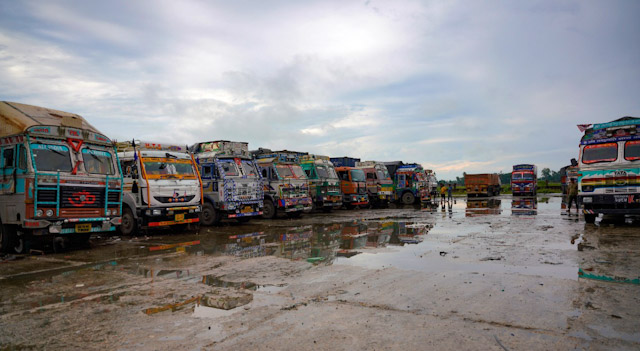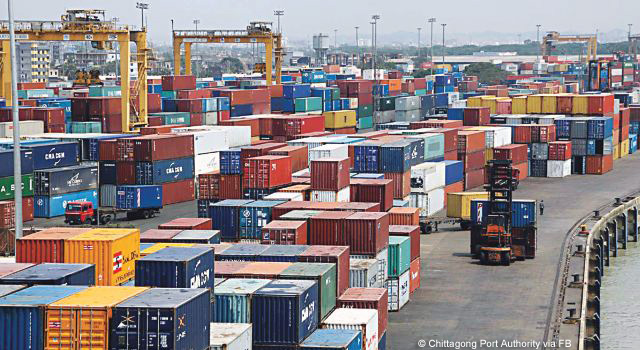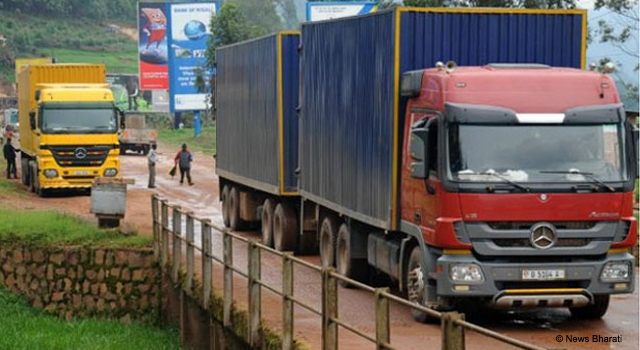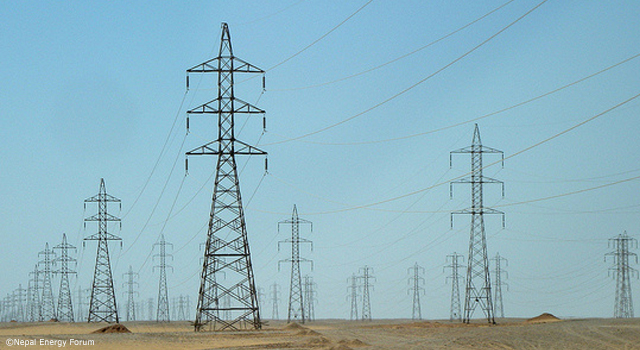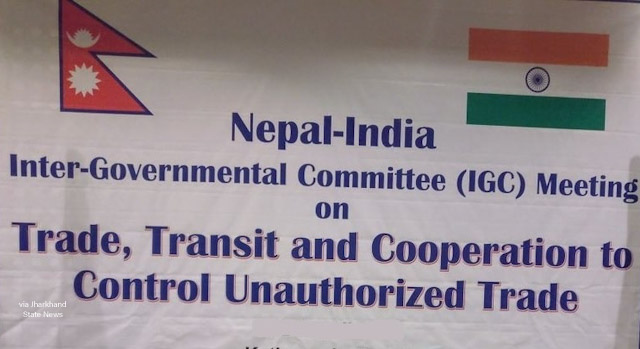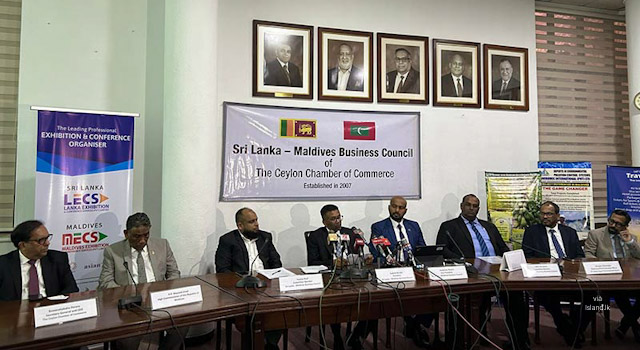
Commentaries on BBIN MVA from Across the Subregion
19 June 2015

Bangladesh, Bhutan, India, and Nepal formed a subregional grouping under the Bangladesh-Bhutan-India-Nepal (BBIN) Framework, and signed a Motor Vehicles Agreement (MVA) allowing seamless transit across each other's territories at the Meeting of Bangladesh, Bhutan, India, and Nepal Transport Ministers on Regional Road Transport Connectivity on 15 June 2015 in Thimphu, Bhutan. Several commentaries from across the region have been published on the BBIN MVA, and are shared below.
Sujeev Shakya, 8 June 2015
When I wrote an article (‘Look East,’ February 18, 2014) on the potential of East South Asia, I never expected it to reflect reality within the next 16 months. The election of Narendra Modi as the prime minister of India with a thumping majority and the priority he placed on India’s neighbours has made this possible.
In a recent two-day visit to Bangladesh, Modi took a risk and settled a 45-year-old dispute over territories in an attempt to bury past differences to focus on future synergies. His regional tour began in Bhutan, which was the first country he visited after assuming power in May 2014. Then, he visited Nepal in August 2014, making reference to quelling doubts on certain sensitive issues relating to Nepal’s pseudo-nationalism and signing a host of economic agreements. He repeated this feat again in Sri Lanka in March 2015 and now, in Bangladesh, he announced a series of agreements on investment and connectivity.
Interestingly, the Indian prime minister had the Chief Minister of West Bengal, Mamata Banerjee, a political foe, with him in Bangladesh when the historic agreements were signed. Until now, India’s engagement with its past has been Delhi-centric, even though key bilateral issues with other countries, like Bangladesh, is linked to the Indian states that border other countries. Post 1984, since the rise of coalition and regional parties in India, many a time, the federal and state governments were run by parties at loggerheads, making regional engagement a complete non-agenda. The future of India’s bilateral relationships with other countries in the region will now depend on how Gangtok, Guwahati, and Kolkata engage with Thimpu, or how Dehradun, Kolkata, Lucknow, and Patna engage with Kathmandu, or how Agartala, Guwahati, and Kolkata engage with Dhaka.
Slow progress
The images of a soap-opera like scene at the 18th Saarc guthi meeting in November 2014—when the world waited for the Indian prime minister to shake hands with his Pakistani counterpart—are still fresh. Therefore, many continue to wonder what a regional cooperation platform can do when the focus is constantly on whether the leaders of two countries shook hands or spoke to each other or not? When can the potential of a common currency, common market, or a common connectivity platform be unleashed? Even 30 years after its formation, Saarc continues to limp from one conference to another, pretty much like how many organisations move from one Annual General Meeting to another.
Still, in January 2015, the second meeting of the Joint Working Group on sub-regional cooperation discussed water resource management, energy, connectivity, and transit. This could be a good start, as bilateral arrangements on these issues already exist between India and Bangladesh and Bhutan and Nepal separately.
Further, the opening of the roads that pass through Bangladesh and connect Indian cities will be a landmark event for the two countries. A trip from Kolkata to Agartala in Tripura will be cut short from 1,650 kilometres to 500 kilometres and will also open up new avenues to access markets and services. With better road infrastructure in the region, along with a rise in the middle-class that can afford private vehicles, there could be a boom in regional tourism. Just prior to the quake in Nepal, there had been a tremendous rise in the number of Indian licence plate vehicles in Nepal and Nepali licence plate vehicles in the border towns of India.
Market for electricity
The key to the growth of this region is energy and grid connectivity between the four countries—Bangladesh, Bhutan, India, and Nepal. This could help ensure an electricity market that can push economic growth. Bhutan, which is a major producer of hydropower, faces the challenge of having only a single bilateral buyer, India. A regional market could ensure that Bhutan has the option of selling its power to Bangladesh or Nepal too. Water continues to play a major role
in integrating the region, as the same rivers flow through different countries. If the Teesta issue gets resolved, it will surely send a powerful message across the region on how India perceives this regional economic bloc.
A new bloc
Economic integration will also depend on the extent to which countries are willing to open up. The fall of the Soviet Union gave rise to many sub-regional groups in Europe. A regional block consisting of Bangladesh, Bhutan, India, and Nepal (BBIN) could be an important one, as Myanmar opens up and provides an opportunity to engage with South East Asian economies.
In Africa, while the discourse on the African Union continues, West African countries and East African countries are creating their own sub-regional groups to foster connectivity and push economic growth. Uganda, Kenya, and Rwanda have launched an East Africa Tourist Visa to facilitate tourism. Similarly, eight West African countries have a currency union that uses the Western African CFA Franc.
In BBIN, Bhutan can have an equal parity with the Indian Rupee and Nepal has a fixed exchange rate with India, which has not changed in the past 25 years. Bangladesh’s currency also fluctuates more in line with the Indian rupee. So rather than waiting for a Saarc monetary union, these four countries could start with a common currency. If India makes its currency completely convertible, it makes more sense to have a common currency rather than peg with a fully-convertible Indian rupee.
As Nepal seeks to rebuild post the earthquake, it must also look into how it can work towards leveraging sub-regional blocs rather than wait for the next Saarc Summit.
Virtues of being well-connected
Sanjaya Baru, 18 June 2015
If China has its One Belt-One Road (Obor), India could have its One Road-One Rail (Oror). Last month India took an important step aimed at building the ‘One Rail’ link from the Iranian port of Chabahar going inland towards Afghanistan and Central Asia. Earlier this week on Monday, Bangladesh, Bhutan, India and Nepal (BBIN) signed a motor vehicles pact that could, in the first instance, ease road transportation across the eastern edges of the subcontinent, eventually linking in to roads in Myanmar and Thailand and onward to the Pacific.
The only missing link is the land access across Pakistan. If Pakistan wishes to also benefit from this trans-Asian rail-road link, cutting across the Gangetic plain, then it should help convert the BBIN motor vehicles agreement into the already-penned South Asian Association for Regional Cooperation (Saarc) motor vehicles agreement, a document waiting to be signed. Pakistan chooses not to, merely to deny India land access to Afghanistan and beyond. That is why the rail project in Iran is important.
Iran’s new leadership shares with South Asian and South-east Asian leaders the view that connectivity is key to both intra-regional trade and to regional economic development. At their last summit, the leaders of the Saarc and the Association of Southeast Asian Nations (Asean) adopted joint statements that emphasised the importance of ‘connectivity’.
It is the first C, connectivity, that Asia needs in order to promote the other C, cooperation. BBIN leaders have agreed to place equal emphasis on all forms of connectivity, including digital. But the first step is building road connectivity.
Interestingly, the portfolio of Bangladesh’s minister for roads is ‘minister of road transport and bridges’. His Indian counterpart’s title is ‘minister of road transport, highways and shipping’ and that of the Nepalese minister is ‘minister of physical infrastructure and transport’.
Infrastructure, highways, bridges, shipping all get connected facilitating the movement of goods and people. The missing minister at the BBIN gathering was the minister of railways. The joint statement adopted by BBIN’s road ministers on June 15 recalls the commitment of Saarc leaders to “deepen regional integration for peace, stability and prosperity in South Asia by intensifying cooperation inter alia in trade, investment, finance, energy, security, infrastructure, connectivity and culture”.
The Saarc leaders had agreed at their last summit to enhance regional connectivity “in a seamless manner” through building and upgrading roads, railways, waterways, energy grids, communication and air links, to “ensure smooth cross-border flow of goods, services, capital, technology and people”.
If BBIN can upgrade their road, rail and port infrastructure and link these to Asean’s, the integration of the Indian subcontinent with Indochina would be enhanced. Turning West, better land linkages to ports in Gujarat and then rail and road links from Chabahar inwards into Central Asia, would link the subcontinent to the Eurasian region.
Taken together, these two initiatives of this past month would be India’s Oror response to China’s Obor. The only difference is that China has pots of money to fund its infrastructure proposals. India has some money, but not enough. That is where Japan can and should step in.
The BBIN initiative was, in fact, aided by the Asian Development Bank’s South Asian Sub-regional Economic Cooperation (Sasec) programme and is the product of the Sasec road connectivity programme. Japan should also step in to fund India’s road-rail projects in Iran. After all, the Oror project can link Iran to coasts along the Pacific, enabling Japan to use a parallel land-based route to energy rich West and Central Asia, and reduce its vital dependence on the Indo-Pacific route.
A word of caution. The ‘seamless’ integration that Saarc leaders conceptualised requires not just good infrastructure but also an efficient administration, trade facilitation systems and simple procedures. At the end of the day, bureaucracy can ruin all plans if the systems that facilitate movement of goods, services, capital and people are not rational, simple and transparent. Already, sceptics in BBIN capitals have expressed concern about the ability of their respective bureaucracies to translate the enthusiasm of their leaders into efficient systems.
So, even as BBIN invest in the creation of infrastructure, they must move quickly to improve the efficiency of their border controls and procedures. The BBIN can learn from the countries of the European Union that have created efficient systems in this regard. On this score, the Asean nations are no better than the BBIN given mutual suspicions within the region and the difficulties associated with intra-regional movement of goods and people.
On the western side, it is reasonable to assume that Pakistan will take a long time before opening up its borders to the free movement of vehicles and goods going from India to Iran and Central Asia. Hence, the importance of the India-Iran agreement on Chabahar and the Indian government’s decision to speed up port, road and rail infrastructure development there. Quietly, but surely, India has launched its own Oror.
BBIN: Inadequate infrastructure key deterrent to trade activities
Asjadul Kibria, 19 June 2015
The concept of sub-regional trading bloc is not a new one. For the last two decades and more, different stakeholders in this region, to be precise South Asia, are looking up to sub-regional approach for enhanced connectivity and unimpeded flow of trade.
Sub-region generally indicates a kind of grouping of few small countries with a part or a territory of a big country or countries. A well cited example of sub-regional initiative is the Greater Mekong Sub-region. Five countries--Cambodia, Laos, Myanmar, Thailand and Vietnam, and Yunnan Province and Guangxi Zhuang Autonomous Region of China are members of the sub-region. All except Guangxi are situated on the Mekong river basin. Asian Development Bank (ADB) in 1992 formally initiated the Greater Mekong Sub-Regional approach.
In a similar vein, a South Asian sub-regional framework is also in the discussion for long. In 2001, ADB formally initiated the South Asian Sub-Regional Economic Cooperation (SASEC) Development programme. Bangladesh, Bhutan, India, Maldives, Nepal and Sri Lanka are members of this sub-region. It actually turned out to be a 'SAARC minus Pakistan' and lacked sub-regional characteristics in many ways. For instance, two island countries are there who couldn't be connected through land or rail links. Again, the largest country of the region India is there, but not some of its provinces or states.
Forming a sub-regional platform comprising Bangladesh, Bhutan, Nepal and the north-eastern states of India has been in the air for long. Lots of discussions and seminars have taken place during last two decades on the subject. Finally, these four countries have agreed to directly link each other under the BBIN (Bangladesh-Bhutan-India-Nepal) framework. To make the sub-regional initiative visible and effective, the BBIN motor vehicle agreement (MVA) has been signed last week in the Bhutanese capital, Thimpu. Under the umbrella agreement, people of these countries will be able to move with their own vehicles across each other's territories. Through this process, trade among these counties is likely to increase with high potential for integrated economic cooperation.
No doubt, India is the prime mover of BBIN. In 2013, then Indian government formally took the agenda of sub-regional bloc on board. In fact, improved relation with Bangladesh since 2009 helped India move with the BBIN agenda with relative ease than any time in the past. It is always easy for India to have Bhutan and Nepal on its side. But bilateral relationship with Bangladesh was not very smooth before 2009. Thus, Bangladesh considered SAARC (South Asian Association for Regional Cooperation) a better platform for trade and economic cooperation. India is, however, always sceptical about SAARC. Indo-Pak tension always cast dark shadows on SAARC and the South Asian regional initiative failed to bring desired results in the last three decades.
After Narendra Modi got elected as Prime Minister of India in 2014, India's external policy seems to have assumed a more neighbour-friendly stance. This is clearly reflected in the quick move to make BBIN a reality. Pakistan's refusal to sign the SAARC motor vehicle agreement (MVA) and the SAARC rail and power network deal at the SAARC summit in Kathmandu in November last year makes it easy for India to move with the BBIN. Had the SAARC road and rail linking deals been signed, then Pakistan and Afghanistan could have also come under the same arrangement in a far more extended form.
BBIN is expected to help land-locked Nepal and Bhutan to get access to Chittagong, Mongla and Kolkata sea ports. Bangladesh was always ready to provide transit facilities to Nepal and Bhutan but couldn't do so due to India's reservations. As the Nepalese and Bhutanese vehicles needed to pass through Indian territory to enter Bangladesh, India denied such access which is clearly non-compliant with the World Trade Organisation (WTO) principle. As per WTO principle, land-locked countries have full right to get transit facility in the second country to access a third country.
Bangladesh's willingness to allow transits facilities to Nepal and Bhutan along with India was clearly reflected in the report prepared by a core-committee on transit. The committee, in 2011, recommended allowing transit to these three countries. In that sense, it is Bangladesh who actually pioneered for linking BBIN countries with one another.
The BBIN intra-region trade stood at US$24.3 billion in 2014 which was $ 5.78 billion a decade ago. India is the largest trading partner of Bangladesh, Bhutan and Nepal. Around 49 per cent of the SAARC intra-region trade is BBIN intra-region trade. The existing trade routes of BBIN are likely to be improved in line with implementing the MVA as lots of improvements in physical infrastructure are required.
One of the existing active trade routes in BBIN is Kathmandu-Karvitta /Panitanki-Phulbari/ Banglabandha-Hatikumrul-Dhaka. It is a 1448 km long road network thorough which bilateral trade between Bangladesh and Nepal takes place. India also uses this route for bilateral trade. In Nepal, its distance is 600 km, in India 54 km and in Bangladesh 498 km (up to Dhaka). If the route is considered up-to Chittagong port, total distance will be around 1700 km. Or, if the route is diverted from Banglabandha to Mongla, total distance will be 1329 km. Interestingly, SAARC regional multimodal transport study (SRMTS) has identified this route as SAARC Highway Corridor-4.
While trade route is there, inadequate infrastructure is the key deterrent to trade activities through out the route. A recent study by Consumer Unity and Trust Society (CUTS), an International research organisation based in Jaipur (India), shows that on the Bangladesh side, road conditions are satisfactory but there are deficiencies such as lack of warehousing and parking spaces. On the Nepal side, Kakarvitta land customs station is well equipped with warehousing, parking spaces and weighbridges, but there is no testing lab. On the India side, Panitanki land customs station is not well equipped as there is no sufficient parking space and warehousing facilities. No officials are permanently posted there to observe the customs formalities. The bridge connecting Panirtanki and Kakarvitta is narrow and congested. This scenario reflects the necessity of adequate infrastructure to make this trade route effective.



